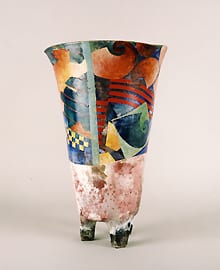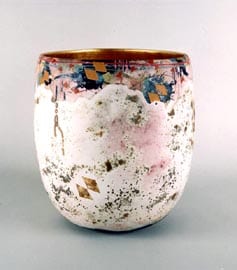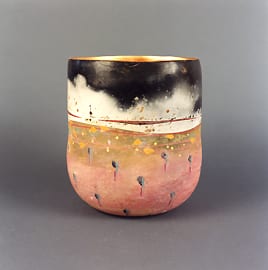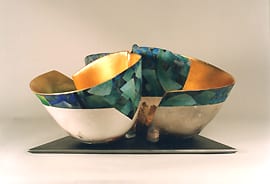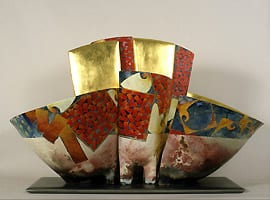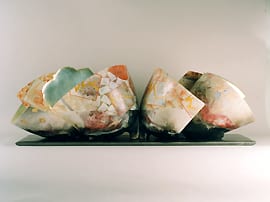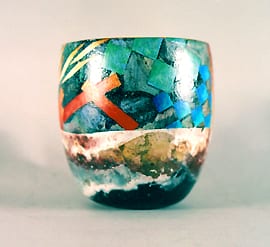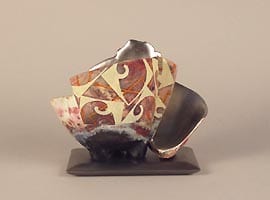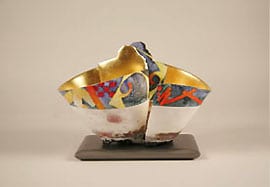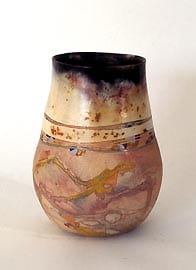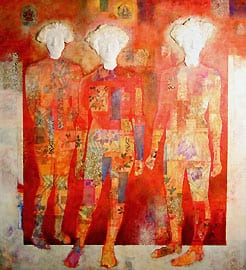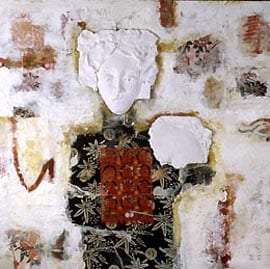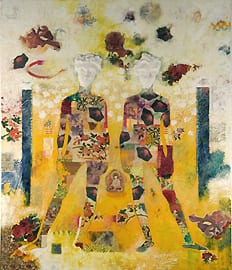
- This event has passed.
Bennett Bean: Thirty Years
May 17, 2006 - August 13, 2006
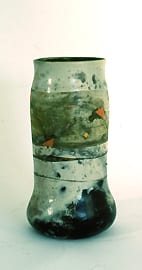
Curatorial Statement
In Bennett Bean’s view, ceramics today are a vehicle for artistic expression. Potters no longer need to make functional wares, and instead use clay as an art medium. The emergence of ceramics as art has been slow compared to other media in which artists made the elements of tradition the subject of their work. “The mistake that most people make,” Bean says, “is that they think the content of ceramics should be the same as art.” He believes that ceramic art should address the “characteristics in ceramics”, and the basic form is the vessel.
Bean has focused on the vessel form throughout his career. He is adamant on the subject of his vessels. ”The two characteristics of the vessel that I have chosen as my subject are decorative surface outside and space inside, with the concomitant unfolding of the relationship between these two elements.” By using these essential concepts, Bean’s work finds consistency and coherence. His pieces are not about use, tactility, volume, or narrative. They are visual representations of his intellectual concerns. He decorates his pots with a punch, bringing color to a level of intensity so that it vibrates “to push the decoration as far as you can.” On the inside, there is no differentiation of surface. The surface is either black or gold leaf -metal, indeterminate depth and surface; it is not easy to determine where it ends. While gold is seductive, it connects with colors, so any surface on the outside can relate to the inside. Eventually gold leaf appears on the exteriors of the pots, which makes the dialogue between interior space and exterior skin more engaging.
One of Bean’s major discoveries was that the pot was not finished when it came out of the kiln. To supplement the decorative effect, over the last 20 years Bean developed what he describes as his process–a series of fifteen steps. His vessels are wheel thrown, dented, trimmed, burnished, cut and assembled; dried, painted with white terra sigillata, burnished, biscuit fired, drawn with tape, partially coated with wax resist; partially glazed, pit fired, gold leafed, in-painted with acrylic and covered with a coat of clear protective urethane.
His mature work has evolved from relatively simple forms of somewhat restrained surface patterning to much more complex compositions of overlapping and interacting forms, with exuberant and assertive decorations. The earlier pieces were in the round and one had to go over the top to get inside. In the later work, with cuts all the way down the side, the piece is opened, allowing the viewer to move in and out as one moves around it. The decoration has a sense of either emerging from the interior or disappearing into the interior.
Since the mid-1990s Bean has segmented his vessels into several fully independent parts. It is a remarkable achievement to have two, three or four elements visually fuse into a single interdependent unit. He creates mini-vessels in curious shapes; but they are not designed to exist by themselves. The individual segments are created to interlock with their companions.
Bean’s use of paint and his decorative motifs play an essential role in unifying the diverse components. He paints these pieced-together vessels as single units, carrying the decoration across the surface as if the space between them does not exist. Creating a sense of order, there are pale effects of pit firing with the dusky blacks and the blushing pinks from copper to selected areas at the bottom of works. The upper part of the vessels appears colorful and vivacious. The motifs are loose and gridded abstraction, a patterning range from diamonds to curlicues. The paint suggests the qualities of watercolor, which is in full harmony with the vessels it covers, and along with the sheen of their gold leaf interiors, hints at preciousness. Bean creates vessels which achieve beauty and aesthetic satisfaction.
His recent works, “Ghost Paintings,” derive from memories of ancestors. “This work happened by accident,” says Bean. While visiting family in Hong Kong, he was invited to a funerary offering store, where offerings designed to be burned at the graves of one’s ancestors are sold. “I was so enchanted by this idea that I bought quite a selection of the offerings, though for no ancestor in particular… but these paintings are my way of dealing with my memories of them. Their memory only exists in my mind. The paintings reflect the quality of these memories–the fragmentary glimpses of those who are gone.”
These works then led naturally into the Memory Series.
Biography
Bennett Bean was born in Cincinnati in 1941. He moved with his family to Iowa City, Iowa, when he was eight, and during his teenage years developed an interest in Native American ethnology, architecture and American music.
In the 1950s, he worked in the peace movement while attending Grinnell College. With an increasingly serious interest in art, he transferred to the State University of Iowa to finish his BA as an art major.
Bean began graduate school in 1964 at Claremont College in California, studying with Paul Soldner and earning the MFA in Painting and Sculpture. In 1966 he was influenced by Japanese water jars, which lead to the Elephant Foot series represented in the current exhibit. He married fellow Claremont student, Cathy Bao (Bean), author of The Chopsticks Fork Principle, A Memoir and Manual; she encourages people to be bicultural.
In 1970-71 they moved to an historic farm in Blairstown, New Jersey, which surrounds their creative lives. Their son, William, was born in 1974. During this time Bennett set up his clay studio and began exploring techniques such as post-fired lusters. He also made a connection with Tibetan Buddhism.
Bean was influenced in the late 1970s by Near Eastern decorative arts and the use of flat pattern. He was also inspired by the concept of space in all senses; this is evident in Theo Anderson’s photo essay of Bean in his space. He was influenced further by Larry Poons’ color field paintings. Bean says this was a period of “intense experimentation, euphoria and terror”.
In the 1980s gold leaf is introduced into his ceramic works. It was during this time that the curators, Dzintra Kalnins and Peggy Whitney Hobbs discovered his work in Clinton, New Jersey, and noticed his Lehigh connection as the nephew of Mary Archer Eppes, wife of the late Professor of Engineering, Jimmy Eppes. Bean was beginning his Wing series and the dramatic Double and Triple series. In 1995 the Drunken Lilly (footed) vessel series began, followed in the new century with his DNA and Ghost series, and currently the Memory series. Curiosity continues for him as “…one of the most essential characteristics”
Bean’s work is included in permanent collections of numerous institutions, such as the Whitney Museum of American Art, New York City; the Cincinnati Art Museum, Cincinnati; the Milwaukee Art Museum, Milwaukee; The Newark Museum, Newark, New Jersey; the Carnegie Museum of Art, Pittsburgh; the Museum of Fine Arts, Boston; and the Royal Ontario Museum, Toronto, Canada.
Bean was a recipient of a National Endowment for the Arts Fellowship. He lives and works in New Jersey.
